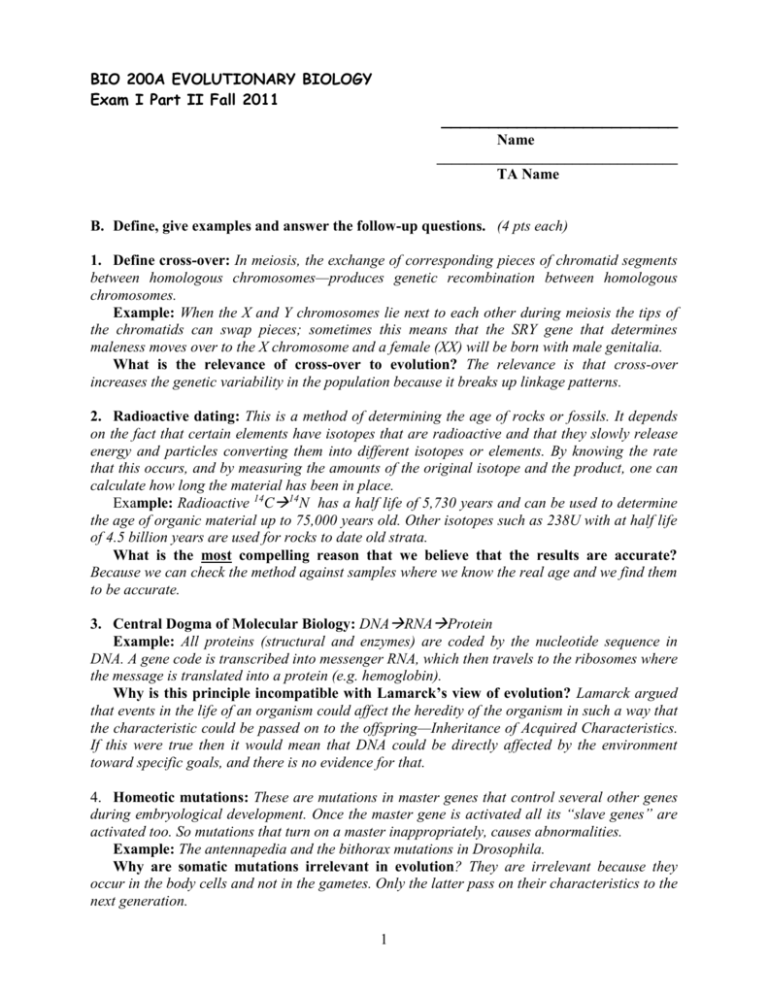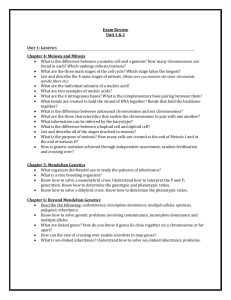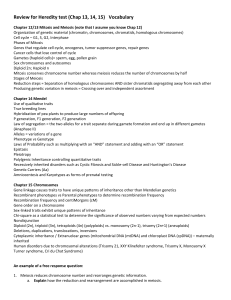BIO 200A EVOLUTIONARY BIOLOGY - Bio 200 Evolutionary Biology
advertisement

BIO 200A EVOLUTIONARY BIOLOGY Exam I Part II Fall 2011 _________________________ Name ________________________________ TA Name B. Define, give examples and answer the follow-up questions. (4 pts each) 1. Define cross-over: In meiosis, the exchange of corresponding pieces of chromatid segments between homologous chromosomes—produces genetic recombination between homologous chromosomes. Example: When the X and Y chromosomes lie next to each other during meiosis the tips of the chromatids can swap pieces; sometimes this means that the SRY gene that determines maleness moves over to the X chromosome and a female (XX) will be born with male genitalia. What is the relevance of cross-over to evolution? The relevance is that cross-over increases the genetic variability in the population because it breaks up linkage patterns. 2. Radioactive dating: This is a method of determining the age of rocks or fossils. It depends on the fact that certain elements have isotopes that are radioactive and that they slowly release energy and particles converting them into different isotopes or elements. By knowing the rate that this occurs, and by measuring the amounts of the original isotope and the product, one can calculate how long the material has been in place. Example: Radioactive 14C14N has a half life of 5,730 years and can be used to determine the age of organic material up to 75,000 years old. Other isotopes such as 238U with at half life of 4.5 billion years are used for rocks to date old strata. What is the most compelling reason that we believe that the results are accurate? Because we can check the method against samples where we know the real age and we find them to be accurate. 3. Central Dogma of Molecular Biology: DNARNAProtein Example: All proteins (structural and enzymes) are coded by the nucleotide sequence in DNA. A gene code is transcribed into messenger RNA, which then travels to the ribosomes where the message is translated into a protein (e.g. hemoglobin). Why is this principle incompatible with Lamarck’s view of evolution? Lamarck argued that events in the life of an organism could affect the heredity of the organism in such a way that the characteristic could be passed on to the offspring—Inheritance of Acquired Characteristics. If this were true then it would mean that DNA could be directly affected by the environment toward specific goals, and there is no evidence for that. 4. Homeotic mutations: These are mutations in master genes that control several other genes during embryological development. Once the master gene is activated all its “slave genes” are activated too. So mutations that turn on a master inappropriately, causes abnormalities. Example: The antennapedia and the bithorax mutations in Drosophila. Why are somatic mutations irrelevant in evolution? They are irrelevant because they occur in the body cells and not in the gametes. Only the latter pass on their characteristics to the next generation. 1 C. Comment on whether the following statements are true or false and explain your reasoning. (3 pts each) 1. Science as a discipline takes no position on the existence of gods or a God. True. Gods are supernatural beings often with unlimited powers and science does not deal with supernatural entities. It confines its scope to the natural world. 2. Without mutation evolution would stop. True. If you rule out mutation, you rule out any new variations that could be introduced into the population. In the short run, variability could still occur by the shuffling of alleles because of sexual reproduction and recombination so evolution could occur. But eventually, all of the poor arrangements would have been eliminated by natural selection and effectively nothing new could occur and the population would be stabilized, i.e. no evolution. 3. It is impossible for a person to have to have xy chromosomes and have female anatomy. False. If a person had lost the SRY gene during cross-over during meiosis in the father, then it could happen. It is the SRY gene that initiates the development of the male hormones at the 7th week of human development. If it is absent, female anatomy will result. 4. An addition point mutation is much more likely to lead to a non-functional gene than a substitution. True. A substitution mutation will only change one nucleotide unit for another (e.g. substituting adenine for guanine), and so will normally will result in one amino acid being substituted for another. (And even that might not occur if the codons are equivalent, coding for the same amino acid). In contrast, the addition of a new nucleotide into a functioning gene will cause a frame shift so that all of the subsequent codons are altered and this will cause the entire protein to be nonsense, or non-functional because it is so drastically altered. 5. Stabilizing selection reduces genetic variability while disruptive selection increases it. True. Stabilizing selection is the process whereby individuals with extreme variations are eliminated from the population—e.g. the tallest and the shortest individuals. This means that the variation in the population is reduced in each subsequent generation. In contrast, disruptive selection means that the average individuals are selected against so that the extreme individuals in the population are favored. This means the population is continuously made more diverse, and if this continues, the population will slowly diverge into two different populations—e.g. small individuals and short, since the middl- sized individuals are being continuously eliminated. 2 D. List Questions 1. List 3 statements that are true about prokaryotic but not true about eukaryotes. (3 pts) a) No nuclear membrane in prokaryotes b) No mitochondria, chloroplasts, ER, Golgi, 9+2 flagella, lysosomes, vacuoles c) No mitosis or meiosis d) Single circular chromosome e) Oldest fossils on earth f) Smallest cells on earth 2. List 3 ways that meiosis is different from mitosis. (3 pts) a) Meiosis goes through two cell divisions and mitosis only one b) Meiosis produces 4 haploid cells and mitosis results in two diploid cells c) Meiotic division (meiosis I) has the two sister chromosomes line up next to one another where cross-over occurs between the chromatids. During mitosis the sister chromosomes do not lie next to one another; all chromosomes line up directly below one another in a single row. 3. List and explain three (3) major problems or criticisms that Darwin could not solve, and then describe in detail how we have resolved these problems today. (9 pts) a) Darwin did not know the age of the earth and so could not answer the critics who claimed that the earth was not old enough for evolution to occur the way that he described it.. Today, because of radioactive dating we know the earth is 4.6 billion years old, plenty of time for evolution to occur. b) Fleeming Jenkin argued that if a better specialized organism happened to occur in the population that rather than it surviving and spreading its good traits around into the next generation, that it would have to breed with the average individuals. So that its good trait would be progressively diluted and lost with each succeeding generation, because traits blended together during breeding. Today, we know that genes do not blend together. First, shown by Mendel, the blending hypothesis is wrong. Genes remain distinct and so that good traits can indeed be selected by the environment (natural selection) and be passed onto the next generation. c) Critics said that Darwin did not know how variations are developed. Today we know that DNA develops mutations during replication and that these are the fundamental source of variation in the population. d) Critics asked where are the intermediate fossils (“transition species”) that should occur if organisms are changing over time? Today, we have hundreds of transition species that show the very intermediate connections that we anticipate. Archaeopteryx is a famous example, but there are many more including fossil whale intermediates and horse intermediates, and hundreds of human intermediate fossils. 3 E. Make a phenogram with labels indicating on what basis you made the separations for the following “organisms”: bacterium, virus, goldfish, whale, apple tree, and a frog. (4 pts) Any number of possible diagrams can be constructed. 4








